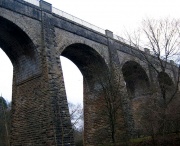Difference between revisions of "Avon Aqueduct, Linlithgow"
| Line 1: | Line 1: | ||
[[Image:Im2010Wik-AvonAq.jpg|thumb| Avon Aqueduct. ]] | [[Image:Im2010Wik-AvonAq.jpg|thumb| Avon Aqueduct. ]] | ||
The Avon Aqueduct is a navigable aqueduct on the Union Canal near Linlithgow, West Lothian. | The Avon Aqueduct is a navigable aqueduct on the [[Union Canal]] near Linlithgow, West Lothian. | ||
It is 810 feet long and 86 feet high; it is the longest and tallest aqueduct in Scotland, and the second longest in Britain (after the Pontcysyllte Aqueduct in Wales). It can be viewed from Muiravonside Country Park. | It is 810 feet long and 86 feet high; it is the longest and tallest aqueduct in Scotland, and the second longest in Britain (after the Pontcysyllte Aqueduct in Wales). It can be viewed from Muiravonside Country Park. There are twelve arches, and the water is carried in a cast iron trough. There is a towpath along both sides. | ||
It was constructed between 1819–21 by [[Craven, Whitaker and Nowell]], with [[Hugh Baird]] as the Engineer, with advice from [[Thomas Telford]]. One source states that the castings for the iron troughs of the Avon and Slateford aqueducts were supplied by Mr. Anderson's Leith Walk Foundry. | |||
<ref>[https://books.google.co.uk/books?id=X9XmZQZB0pIC&pg=PA26&lpg=PA26&dq=%22craven,+whitaker+%26+nowell%22&source=bl&ots=zhB9TM-jZy&sig=ACfU3U0p2p4HeFQ29ZQTkiRG7IYDNS-SBw&hl=en&sa=X&ved=2ahUKEwjTks3qwd7iAhVUSxUIHUGACbAQ6AEwAHoECAQQAQ#v=onepage&q=%22craven%2C%20whitaker%20%26%20nowell%22&f=false] The Millennium Link: The Rehabilitation of the Forth & Clyde and Union Canals, edited by George Fleming, I.C.E., 2000</ref> | |||
See also [[Slateford Aqueduct, Edinburgh]]. | |||
Revision as of 15:49, 15 June 2019
The Avon Aqueduct is a navigable aqueduct on the Union Canal near Linlithgow, West Lothian.
It is 810 feet long and 86 feet high; it is the longest and tallest aqueduct in Scotland, and the second longest in Britain (after the Pontcysyllte Aqueduct in Wales). It can be viewed from Muiravonside Country Park. There are twelve arches, and the water is carried in a cast iron trough. There is a towpath along both sides.
It was constructed between 1819–21 by Craven, Whitaker and Nowell, with Hugh Baird as the Engineer, with advice from Thomas Telford. One source states that the castings for the iron troughs of the Avon and Slateford aqueducts were supplied by Mr. Anderson's Leith Walk Foundry. [1]
See also Slateford Aqueduct, Edinburgh.
See Also
Sources of Information
- [2] Wikipedia


